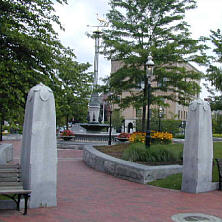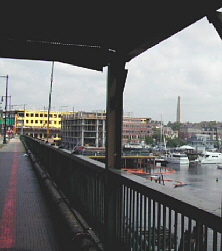CHARLESTOWNMASSACHUSETTS |
 |
CHARLESTOWNMASSACHUSETTS |
 |
Prior to the Battle of Bunker Hill, Charlestown was destroyed by fire from British cannons. Around 1980, archeologists uncovered some remains of the original city and placed ground markers in City Square where buildings were found.

|
English Settlement
and Colonial Era Charlestown was settled on June 24, 1629 by Thomas Graves, an engineer dispatched from England to prepare a site for the newly-chartered Massachusetts Bay Company. With the assistance of 100 colonists from Salem, Graves laid out the town and oversaw the construction of the Governor’s residence, known as the “Great House.” In June 1630, Governor John Winthrop moved into the Great House, which briefly served as the Company’s meeting house and seat of government until Winthrop relocated to the Shawmut peninsula in October of 1630. This area was the heart of a thriving commercial port, and maintained its civic prominence through the colonial era as the location of the town’s tavern, meeting house (1716), and court house (1735). This center of commerce, religion and government served as a marketplace for the colonists and the site of the town’s stocks, whipping posts and pillory. Charlestown was destroyed by bombardment and fire on June 17, 1775 during the Battle of Bunker Hill. (Charlestown Marker) |
General George Washington arrived in Cambridge on July 2, 1775 to take command of the Patriot Forces. On March 2, 1776, he began a bombardment of the British forces for three days with some of the artillery transported by Henry Knox. The bombardment, however, was just a distraction while the main body of artillery was placed south of Boston at Dorchester Heights and revealed on March 4th. The British attempted and attack on Dorchester Heights, but under the threat of bombardment, they evacuated Boston on March 17th.
 Enroute to the
North End
Enroute to the
North EndCharlestown Bridge - Across the Charles River.
